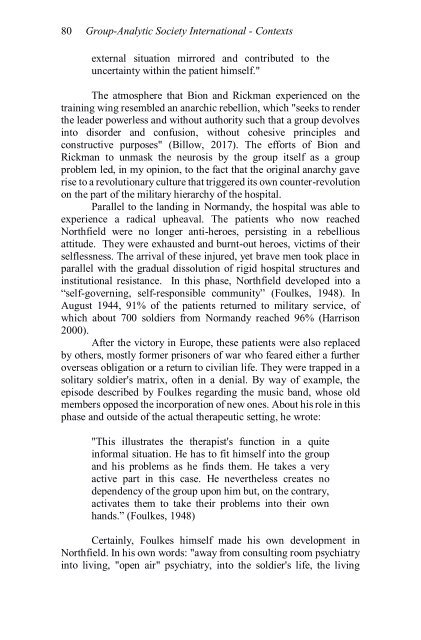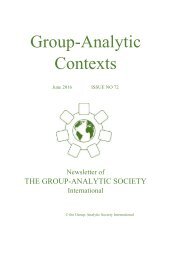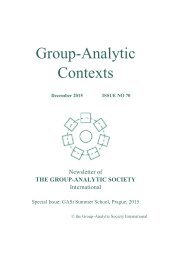Group Analytic Contexts, Issue 77, September 2017
Newsletter of the Group Analytic Society International
Newsletter of the Group Analytic Society International
You also want an ePaper? Increase the reach of your titles
YUMPU automatically turns print PDFs into web optimized ePapers that Google loves.
80 <strong>Group</strong>-<strong>Analytic</strong> Society International - <strong>Contexts</strong><br />
external situation mirrored and contributed to the<br />
uncertainty within the patient himself."<br />
The atmosphere that Bion and Rickman experienced on the<br />
training wing resembled an anarchic rebellion, which "seeks to render<br />
the leader powerless and without authority such that a group devolves<br />
into disorder and confusion, without cohesive principles and<br />
constructive purposes" (Billow, <strong>2017</strong>). The efforts of Bion and<br />
Rickman to unmask the neurosis by the group itself as a group<br />
problem led, in my opinion, to the fact that the original anarchy gave<br />
rise to a revolutionary culture that triggered its own counter-revolution<br />
on the part of the military hierarchy of the hospital.<br />
Parallel to the landing in Normandy, the hospital was able to<br />
experience a radical upheaval. The patients who now reached<br />
Northfield were no longer anti-heroes, persisting in a rebellious<br />
attitude. They were exhausted and burnt-out heroes, victims of their<br />
selflessness. The arrival of these injured, yet brave men took place in<br />
parallel with the gradual dissolution of rigid hospital structures and<br />
institutional resistance. In this phase, Northfield developed into a<br />
“self-governing, self-responsible community” (Foulkes, 1948). In<br />
August 1944, 91% of the patients returned to military service, of<br />
which about 700 soldiers from Normandy reached 96% (Harrison<br />
2000).<br />
After the victory in Europe, these patients were also replaced<br />
by others, mostly former prisoners of war who feared either a further<br />
overseas obligation or a return to civilian life. They were trapped in a<br />
solitary soldier's matrix, often in a denial. By way of example, the<br />
episode described by Foulkes regarding the music band, whose old<br />
members opposed the incorporation of new ones. About his role in this<br />
phase and outside of the actual therapeutic setting, he wrote:<br />
"This illustrates the therapist's function in a quite<br />
informal situation. He has to fit himself into the group<br />
and his problems as he finds them. He takes a very<br />
active part in this case. He nevertheless creates no<br />
dependency of the group upon him but, on the contrary,<br />
activates them to take their problems into their own<br />
hands.” (Foulkes, 1948)<br />
Certainly, Foulkes himself made his own development in<br />
Northfield. In his own words: "away from consulting room psychiatry<br />
into living, "open air" psychiatry, into the soldier's life, the living













